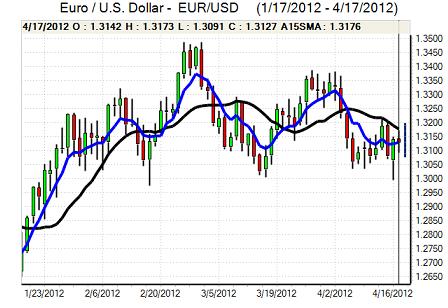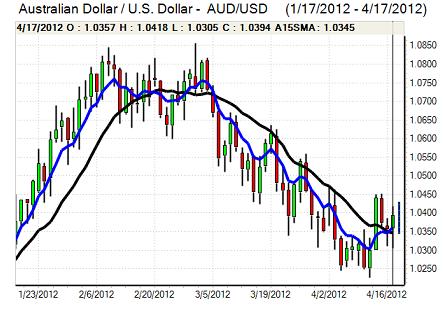EUR/USD
The Euro found support close to 1.31 against the dollar on Tuesday and rallied ahead of the US open with an attack on resistance levels above 1.3150.
The German ZEW index was stronger than expected with a further small increase to 23.4 for April from 22.3 previously, in contrast to expectations of a measured retreat. The ZEW also commented that there had been no noticeable deterioration in replies received later in the survey period which eased fears surrounding the outlook, although there was still a mood of caution. The final Euro-zone March inflation rate recorded a small increase to 2.7% from the 2.6% flash estimate.
There was a rise in yields at the latest Spanish Treasury bill auction, but there was an increase investor demand which helped ease fears surrounding capital markets and the banking sector. The government also attempted to take a positive tone surrounding structural developments and the economic outlook. There were still fears that the underlying situation was unsustainable as the economy continued to contract and there were reports of tensions between Germany and Spain over the EFSF. Markets were also cautious over Thursday’s Spanish bond auction.
There was a decline in US housing starts in the latest data to an annual rate of 0.65mn from 0.69mn previously. Unease over a slowdown in the sector was offset by a rise in permits to a 4-year high and the overall impact was limited. There was no change in industrial production for the month which was weaker than expected.
The Euro was unable to take full advantage of the German data and also failed to gain strong support from sharp gains on Wall Street and consolidated just below the 1.3150 level with reports of BIS selling around this level.

Source: VantagePoint Intermarket Analysis Software
Call now and you will be provided with FREE recent forecasts
that are up to 86% accurate* 800-732-5407
If you would rather have the recent forecasts sent to you, please go here
Yen
The dollar found fresh support on dips towards 80.30 against the yen on Tuesday and rallied consistently during the US session with highs near 81. The dollar gained some net support from the US data, although the primary influence was a dip in yen support following the strong gains on Wall Street as the yen retreated on the crosses.
This trend continued in Asian trading on Wednesday with the dollar pushing to a high around 81.40 as there was further solid yen selling as risk appetite improved. There were also expectations that the Bank of Japan would take further action to relax monetary policy to help underpin the economy.
Sterling
Sterling found support on dips towards 1.5850 against the dollar on Tuesday and rallied sharply to a peak above 1.5950. The headline UK inflation rate rose slightly to 3.5% for March from 3.4% previously as prices failed to match the declines seen last year.
The stubbornly high inflation rate will cause unease within the Bank of England, although the overall policy implications may be limited. In theory, inflation pressures would make the Monetary Policy Committee more reluctant to sanction further monetary easing. Nevertheless, the state of demand is likely to be the dominant influence on the bank and will take priority over inflation if there are renewed fears surrounding the economic outlook and recession threat.
The IMF stated that the Bank of England did have scope for further relaxation on monetary policy.
Sterling continued to gain support from defensive inflows from the Euro-zone and held stronger than 0.8250 against the Euro. The wider gain in stocks also helped underpin the currency through risk appetite, but it was unable to make a challenge on 1.60 against the US currency.
Swiss franc
The dollar was unable to make a serious attack on the 0.92 level against the franc during Tuesday and retreated to test support below 0.9150 in generally cautious trading conditions. Again, the Euro was unable to make any impression on the Swiss currency as it retreated back towards the 1.2010 level.
There was further speculation over defensive capital inflows into the franc as Euro-zone structural fears remained an important focus. There were reports of the BIS Euro/dollar selling on behalf of the National Bank which suggested that there had been persistent intervention to protect the 1.20 minimum level.

Source: VantagePoint Intermarket Analysis Software
Call now and you will be provided with FREE recent forecasts
that are up to 86% accurate* 800-732-5407
If you would rather have the recent forecasts sent to you, please go here
Australian dollar
The Australian dollar found solid support on dips back towards 1.03 against the US currency on Tuesday and rallied steadily during the day with a peak just above the 1.04 level. The currency was underpinned by a generally weaker US tone as well a strong advance on Wall Street as global risk appetite improved.
The latest economic data suggested a decline in Chinese house prices which had some negative impact on the Australian currency, especially with expectations of a Reserve Bank interest rate cut at the May meeting and it was unable to move much above the 1.04 level.



